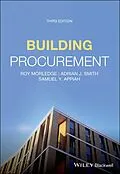As an industrial process, construction is unique. The procurement processes used to achieve the successful completion of built assets requires a different approach to that adopted in most other industries, due to the design of buildings being bespoke and the sites being geographically varied. The procurement process is central to the success of any construction project and many of the problems which impact construction projects can be traced back to the procurement phase, so a good understanding of the methods of procurement, the development of a procurement strategy and the influence it has on project success is essential for all those working in the industry.
Much has changed in the global construction industry since publication of the second edition ofBuilding Procurement,for example the increase in debt burden of many major economies, widespread adoption of Building Information Modelling (BIM) Technology in the industry and the United Kingdom's exit from the European Union. This new edition has been rewritten to take account of these significant developments, but at its core it continues to provide a critical examination and review of current procurement practices in the UK, continental Europe (including EU procurement procedures), China, Middle East and Sub-Saharan Africa and the USA. It retains its original strong emphasis on the need for clients to establish achievable objectives which reflect the project business case and focuses on development of suitable strategies and management structures to meet those objectives in the current construction climate.
Building Procurement will be essential reading for senior undergraduate and postgraduate students of construction management and practitioners working in all areas of construction management.
Autorentext
ABOUT THE AUTHORS
Roy Morledge is Professor Emeritus of Construction Procurement, Nottingham Trent University.
Adrian Smith is a Senior Consultant in Procurement and Project Management at Stradia Ltd, Sheffield and former Visiting Professor at Nottingham Trent University. Adrian is also a Tutor at the College of Estate Management, Reading.
Samuel Appiah is a Director at Stanwell Consulting Ltd and Principal Consultant at HLN Ltd. He is also a Part-time Tutor at Nottingham Trent University.
Inhalt
Preface to the Third Edition xvii
1 Introduction 1
References 5
2 Procurement Strategy: A Literature Review 7
Introduction and Early History 7
Procurement Route Selection Models 8
Towards a Broader View 9
Defining Project Success 11
Team Relationships, Supply Chain Management and Communication and Their Effect on Project Performance 12
Teamwork and Team Performance 12
Partnering: Introduction and Early Development 14
Partnering: A Critical Review 14
Partnering Variants 17
Partnering Dissected 17
Procurement and Multicultural Teams 18
Supply Chain Management 19
The Role of the Client in the Procurement Process 20
The Interrelationship Between the Components of the Overall Procurement Approach: Strategic Procurement Management 21
Legal and Contractual Issues, Including Public Sector Procurement Legislation, and Their Effect on Project Performance 22
International Procurement Comparisons and the Impact of Cultural Differences 24
Risk Allocation and Reward 26
Bid Evaluation Techniques 27
Environmental and Sustainability Issues and the Procurement of Construction Work 29
Sustainable Procurement for Construction Projects 31
Conclusion 32
References 33
3 Principles of Strategic Procurement 49
Introduction 49
Procurement: A Review of Theory and Practice 52
A Strategic Approach to Procurement 54
Components of the Procurement Process 54
Functional Needs Analysis 55
Development of an Overall Procurement Philosophy 55
Components of a Collaborative Relationship 57
Detailed Design of the Procurement Approach 59
Formalisation of Contractual Relationships 59
Selection of the Most Appropriate Partners 60
Implementation 61
Collaborative Procurement in the Public Sector 61
Conclusion 62
References 63
4 Public Sector Projects 65
Introduction: Why Should Public Sector Projects Be Different? 65
What Constitutes the Public Sector? 66
Central Government 67
Government and the Construction Industry 68
Building Information Modelling 70
Responsible Agencies 70
The Gateway Process 70
Local Government and Other Bodies Governed by Public Law 72
Best Value 73
The Public Contracts Regulations 2015 74
References 74
5 Project Initiation 77
Introduction 77
Strategic Fit 78
Payback 79
Assessment of Options 82
Achievability 83
Affordability 83
Defining the Project 84
Prioritisation of Objectives 84
Conclusion 86
References 87
6 Briefing and the Design Process 89
Introduction 89
Project Briefing: An Overview 89
Types of Construction Client 91
Questions to Determine the Type of Client 93
Time 93
Cost 93
Quality 94
Likelihood of Post-Contract Client Changes 94
Degree of Accountability Required 94
Project Complexity 94
The Briefing Process 94
Briefing: A Historical Perspective 95
Different Briefing Approaches 96
The Generic Types of Brief 97
Developing the Strategic Brief 98
Developing the Project Brief 99
The Project Execution Plan 100
What Issues Does the PEP Need to Address? 101
When Should It Be Prepared? 102
Who Prepares the PEP? 103
How Is the PEP Prepared? 103
Project Briefing: The Case of Hospitals 104
Critical Factors for Success in the Briefing Process 105
Referen...
